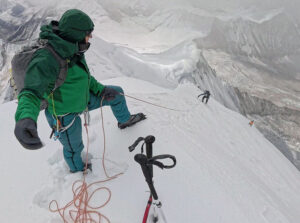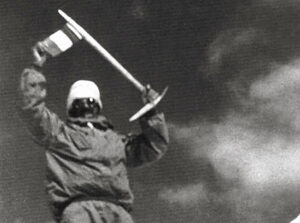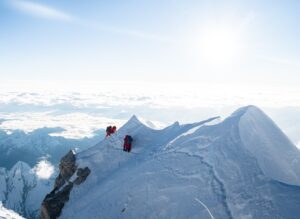Anurag Maloo’s smile is the result of a series of miracles. The Indian climber fell into a crevasse at the most dangerous section of Annapurna, the most dangerous mountain in Nepal. Witnesses considered the plunge deadly. When rescuers reached the site of the accident three days later, they were surprised to find him alive.
Then there was a journey through several hospitals where doctors managed to keep him alive against all odds.
Maloo awoke in the hospital but still faced months of recovery and many surgeries. Yesterday, he finally saw his family home in Kishangarh, Rajasthan again. He has a unique story to share.
“The mountain protected me”
Anurag Maloo only has words of gratefulness — to his rescuers, to his family, to the doctors in the Manipal hospital in Pokhara, Mediciti hospital in Kathmandu and Delhi’s AIIMS hospital, to those who retained hope, and not least of all, to Annapurna itself.

Maloo’s first miracle was his rescue. The second miracle was Dr. Ashim of the Manipal Hospital in Pokhara, who performed CRP for hours, determined to keep him alive. Photo: Anurag Maloo
“The mountain kept me safe, sheltered from avalanches and the freezing winds in its womb of ice, and then put Adam Bielecki on the way,” he says. “She sent me back home, the mother mountain protected me…they found me resting on my right side, in a fetal position.”

Maloo was surrounded by the medical team who looked after him for months at the AIIMS Hospital in Delhi, India. Photo: Anurag Maloo’s family
He does not remember the fall and the three days spent inside the crevasse, but he knows that he eventually moved his limbs. He discovered this after the rescue when he saw the images recorded by his head camera while the battery lasted.
“My brother recovered the camera and found out I had recorded the inside of the crevasse,” Maloo said.

Anurag Maloo (right) with his brother and his father. After Anurag Maloo fell in the crevasse, his family never stopped moving heaven and earth to keep the rescue efforts going. Photo: Anurag Maloo
Hints of life
He was unconscious when Adam Bielecki rappelled 70m (the full length of his rope) down to him in the crevasse and found that Maloo showed some hints of life.
“Later, during my stay in the hospital, I watched the footage of the rescue time after time, and I was amazed at the complexity of the techniques required,” he said. “I also read all I could find about my accident and rescue, my own story.”
During this time, Maloo had a chance to thank Bielecki in person and he kept in touch with the Polish climber.
“He is an amazing person with a pure sense of mountaineering,” Maloo said. “I asked him why. Why had he saved me? And Adam [Bielecki] replied: ‘I was there and you needed help. Another time I could be the one in need.’ ”
After nearly seven months in the hospital, Anurag is midway through a very long journey to recovery. However, given the starting point, his progress is amazing. Anurag has lost all the fingertips on his right hand, which he can barely move. He has also lost the muscle memory of his legs, so he is in the process of learning how to stand and walk again. But, surprisingly, his internal organs are all working properly, even his lungs and kidneys, which were non-functional for a long time.

Maloo’s frostbitten side required big patches of transplanted skin. Photo: Anurag Maloo
The most problematic recovery process now is the huge areas of transplanted skin. Most of this is on his right side, which was in contact with the ice and was completely frostbitten when he was rescued. He needed skin transplants from his thighs and calves, and the new skin needed a long time to adapt and become flexible.
Why Annapurna?
Annapurna was Maloo’s first 8,000’er, quite a hard choice for a first experience. Yet he was not a mountaineering newbie. On the contrary, he had followed a logical progression, from an expedition in Antarctica to some trekking in Nepal, several 6,000’ers in Ladakh, then climbed 7,135m Nun (check the IG video below), and finally Ama Dablam (6,812m), before heading for a big 8,000’er. Nevertheless, we asked him: Why Annapurna? Why not start with something easier?
Maloo admitted that in Base Camp, only one other climber (Alina Pekova from Russia) was on their first 8,000m experience among those on the Seven Summit Treks team. “Everyone was surprised because Annapurna is usually among the last peaks to climb among the 14,” Maloo said.
“However, Annapurna was special for me, I have always looked at it as the mother mountain. I know that this is a very illogical answer, but it is how I feel. I started climbing mountains for my grandmother, who passed away one and a half years ago. She was my favorite person in the world. Every mountaintop I reached, I felt her presence around me, next to me.
A deliberate choice
“I had always wanted Annapurna to be my first 8,000’er precisely because it is the hardest, the deadliest. If I could climb Annapurna, I believed I could climb any mountain. I know it is irrational, but that is what I honestly thought. After Annapurna, I planned to climb Everest, Lhotse, and Makalu. That was my plan for 2023.”
Asked about what he should have done differently on his expedition, he said, “I should have made sure my sherpa descended in front of me, next to me, close to me, and not behind. Probably I wouldn’t have made the mistake I made with the rope.”
During the descent, at a snow anchor with two ropes hanging from it, Maloo took the wrong rope. It was too short and had no knot at the end, so he rapped off and fell into the crevasse directly below.
“I was sure I was fit to climb Annapurna, and I was sensible and careful enough to turn around without reaching the summit when I considered it was getting too late. I planned to try again a few days later, but I am not a self-sufficient climber on 8,000’ers. I am not an alpinist, I need guiding and support.”

The cut rope that Maloo used is circled in orange. To its left, another, longer rope that reaches to the end of the rappel. Photo: @moesesfiamoncini
Anurag started climbing intensively during COVID. Before that, he traveled most of the year for professional reasons. He is an international development consultant for emerging markets.
Professional rescue team needed
After his close call, Maloo has been following the expeditions on the Himalayan peaks, and reflected on the current state of commercial climbing and what could be done to avoid accidents like his.
“I have had plenty of time to reflect, and I think it is essential to have a dedicated, trained rescue team,” he said. “I was saved because Adam Bielecki and Maiusz Hatala were there. The rescue involved complex techniques, skills, and mindset. Otherwise, I wouldn’t be alive now.”
A sherpa team also helped in the rescue, but it was the Polish pair who managed the rope operation.

Adam Bielecki inside the crevasse on Annapurna, rescuing Anurag Maloo. Photo: Adam Bielecki
“These rescue teams should be ready to help mountaineers in trouble, especially at 6,000 and 7,000 meters,” Maloo added. “I am aware rescues above 8,000m are so difficult, but somehow lower down, there is a lot a well-trained rescue team could do.”
He adds:
“And mountaineers also must get to the mountain equipped not only with gear but also with training and skills needed, not just show up at an 8,000’er with no previous experience.”
Anurag Maloo has gone through a long journey home and still has a long way to go in terms of recovery. Yet he is well on the way to walk again. And the question is: If all goes well, would he like to return to the mountains, even consider Annapurna again?
“Yes, definitely,” he replied. “There is no question, I will be back to Annapurna and other mountains. But I will not go if I am not fully recovered and ready. I will listen carefully to my body and my recovery process. If I am ready, I will climb again.”

Maloo is still learning to walk but is determined to climb again.






